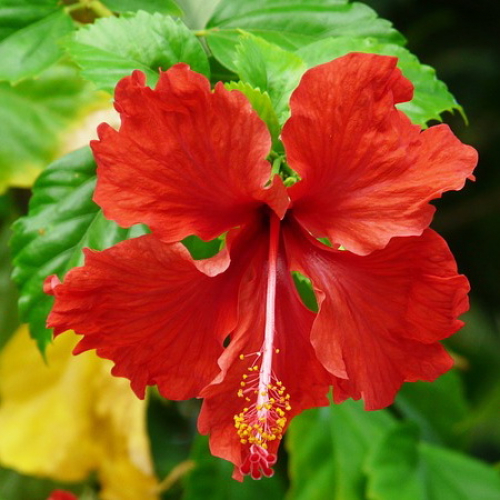Indoor plants Hibiscus

Description
Characteristic Features of Hibiscus
Hibiscus is a genus of plants of the mallow family Malvaceae that includes mostly shrubs and trees, as well as perennial and annual herbaceous plants. Botanists debate on how many species the genus contains: 150? 200? 220? Or even around 300?
Hibiscus is widespread both in the Old and the New World. Though it is native to the tropics and subtropics, owing to the knowledge, skills, and experience of plant enthusiasts Hibiscus feels comfortable and safe in any climate.
Two wild species are found in the CIS, Hibiscus syriacus and Hibiscus trionum, also known as the flower-of-an-hour. The most globally widespread species is Hibiscus moscheutos. However, the following species are much better known:
- Rosella (Hibiscus sabdariffa), or Rose of Althea. Its flowers (or more precisely, dried bracts) are used to make the famous Hibiscus tea drink that is sometimes referred to as the drink of the Pharaohs' or Venice Mallow.
- Hibiscus cannabinus, or kenaf, grown in the US, China, India, Brazil, and many other (most likely all) tropical countries. It is a superior spinning material used in the production of technical textiles. Dry Kenaf stems contain up to 21% of valuable fibers, while seeds contain up to 20% of technical oils.
- Hibiscus rosa-sinensis, or China rose, which is indigenous to the Malay Archipelago rather than the Celestial Empire. This variety is commonly grown as a greenhouse and indoor plant. Its elegant flowers reach 16 centimetres across and are bright red or yellow in colour. Though the huge showy flowers are unlikely to leave anyone indifferent, the leaves are also very attractive, smooth, shiny, dark, and evergreen.
(Hibiscus rosa-sinensis is not to be confused with Rosa chinensis from the genus Rosa, within the family Rosaceae also referred to as Chinese Tea Rose.)
The Secrets to Successfully Growing Hibiscus
Experts say jokingly that the plant is low maintenance but requires a lot of light, space, heat, and moisture. This means that you should do the following:
a) Choose a sunny place for Hibiscus. The ideal position is a wide windowsill. Remember to protect from direct sunlight in the afternoon. In the summer, you can move the pot to the balcony or garden.
b) The temperature should range 18 to 22 ° C in the summer and 14 to 16 ° C in the winter.
c) In the summer, water the plant frequently and thoroughly. The soil should not dry out or be cloggy.
d) You can spray Hibiscus from time to time.
d) During the resting period from November to February make sure your sleeping beauty has good lighting and reduce watering.
In the spring and summer, regularly fertilize the plant with compound mineral fertilizer.
Report Hibiscus in the spring. Young plants should be reported each year, old plants once in 2 or 3 years.
Prepare the potting mix from humus, leaf mold, loam, and sand at 2:1:1:1.
The new pot should be two sizes larger. Ensure good drainage.
Hibiscus rosa-sinensis is propagated in the spring and summer by semilignified cuttings. They root easily and bloom in the same year.
Prune the plant in early spring to stimulate new growth and flowering. With proper pruning and watering, Hibiscus can bloom all year round!
Potential Problems
If the buds do not swell/do not open/drop, the reason may be the following:
- Lack of nutrients,
- Insufficient watering,
- Low temperature,
- Abrupt change of location.
If the plant grows well and looks healthy but does not bloom and the leaves have dirty pink spots, the plant is either overfed with high nitrogen content fertilizer or does not have enough light.
Sluggish leaves evidence insufficient watering.
Wilting leaves and stems with healthy roots are a sign of withering vessels. The reason can be either overwatering in combination with low temperatures or overfeeding with phosphorus fertilizers.
If Hibiscus is affected by fungi, try saving it with the help of fungicide solutions such as Topsin, Topsin-M, Fundazol etc. Mist the solution on the plant (cut and carefully remove wilted and diseased leaves and stems) and the soil until its wet.
The insect pests that greatly harm China rose are spider mites, aphids, and thrips.







 83 827
83 827








